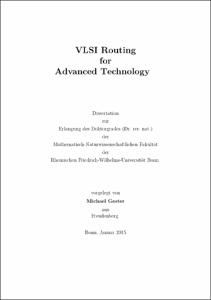VLSI Routing for Advanced Technology

VLSI Routing for Advanced Technology

| dc.contributor.advisor | Vygen, Jens | |
| dc.contributor.author | Gester, Michael | |
| dc.date.accessioned | 2020-04-20T22:13:22Z | |
| dc.date.available | 2020-04-20T22:13:22Z | |
| dc.date.issued | 05.05.2015 | |
| dc.identifier.uri | https://hdl.handle.net/20.500.11811/6457 | |
| dc.description.abstract | Routing is a major step in VLSI design, the design process of complex integrated circuits (commonly known as chips). The basic task in routing is to connect predetermined locations on a chip (pins) with wires which serve as electrical connections. One main challenge in routing for advanced chip technology is the increasing complexity of design rules which reflect manufacturing requirements. In this thesis we investigate various aspects of this challenge. First, we consider polygon decomposition problems in the context of VLSI design rules. We introduce different width notions for polygons which are important for width-dependent design rules in VLSI routing, and we present efficient algorithms for computing width-preserving decompositions of rectilinear polygons into rectangles. Such decompositions are used in routing to allow for fast design rule checking. A main contribution of this thesis is an O(n) time algorithm for computing a decomposition of a simple rectilinear polygon with n vertices into O(n) rectangles, preseverving two-dimensional width. Here the two-dimensional width at a point of the polygon is defined as the edge length of a largest square that contains the point and is contained in the polygon. In order to obtain these results we establish a connection between such decompositions and Voronoi diagrams. Furthermore, we consider implications of multiple patterning and other advanced design rules for VLSI routing. The main contribution in this context is the detailed description of a routing approach which is able to manage such advanced design rules. As a main algorithmic concept we use multi-label shortest paths where certain path properties (which model design rules) can be enforced by defining labels assigned to path vertices and allowing only certain label transitions. The described approach has been implemented in BonnRoute, a VLSI routing tool developed at the Research Institute for Discrete Mathematics, University of Bonn, in cooperation with IBM. We present experimental results confirming that a flow combining BonnRoute and an external cleanup step produces far superior results compared to an industry standard router. In particular, our proposed flow runs more than twice as fast, reduces the via count by more than 20%, the wiring length by more than 10%, and the number of remaining design rule errors by more than 60%. These results obtained by applying our multiple patterning approach to real-world chip instances provided by IBM are another main contribution of this thesis. We note that IBM uses our proposed combined BonnRoute flow as the default tool for signal routing. | en |
| dc.language.iso | eng | |
| dc.rights | In Copyright | |
| dc.rights.uri | http://rightsstatements.org/vocab/InC/1.0/ | |
| dc.subject | Algorithmen | |
| dc.subject | VLSI | |
| dc.subject | Algorithmische Geometrie | |
| dc.subject | Voronoi-Diagramme | |
| dc.subject | Kürzeste Wege | |
| dc.subject | Algorithms | |
| dc.subject | Computational Geometry | |
| dc.subject | Voronoi Diagrams | |
| dc.subject | Shortest Paths | |
| dc.subject.ddc | 510 Mathematik | |
| dc.title | VLSI Routing for Advanced Technology | |
| dc.type | Dissertation oder Habilitation | |
| dc.publisher.name | Universitäts- und Landesbibliothek Bonn | |
| dc.publisher.location | Bonn | |
| dc.rights.accessRights | openAccess | |
| dc.identifier.urn | https://nbn-resolving.org/urn:nbn:de:hbz:5n-39934 | |
| ulbbn.pubtype | Erstveröffentlichung | |
| ulbbnediss.affiliation.name | Rheinische Friedrich-Wilhelms-Universität Bonn | |
| ulbbnediss.affiliation.location | Bonn | |
| ulbbnediss.thesis.level | Dissertation | |
| ulbbnediss.dissID | 3993 | |
| ulbbnediss.date.accepted | 12.03.2015 | |
| ulbbnediss.institute | Zentrale wissenschaftliche Einrichtungen : Forschungsinstitut für Diskrete Mathematik | |
| ulbbnediss.fakultaet | Mathematisch-Naturwissenschaftliche Fakultät | |
| dc.contributor.coReferee | Held, Stephan |
Dateien zu dieser Ressource
Das Dokument erscheint in:
-
E-Dissertationen (4378)




